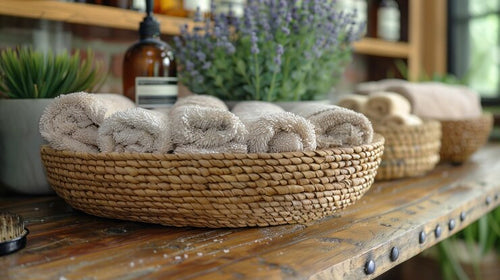Microfiber towels are known to be ten times more effective than regular towels. But are they just as difficult to wash?
Over the past few years, microfiber cloths have infiltrated the housekeeping and self-grooming niche— and for a good reason, too. These textiles have rightfully earned their spot as a domestic staple across the globe. But microfiber fabrics are used for countless other purposes as well, such as car detailing.
Despite their popularity, however, not many people seem to know how to clean them.
We know what you’re thinking: how is it any different than washing your regular cotton towels?
Well, you’re forgetting that microfiber is a very fragile textile. In fact, its fragility is what gives it magnetic superpowers.
Hence, you need to know how to take care of these fabrics accordingly. You’ll soon find that everything about this process—from washer settings to detergents— is different from washing regular fabrics.
How to Wash Microfiber Towels In The Washing Machine

When it comes to a thorough cleaning, nothing gets the job done like a washing machine. Not only is it more efficient and reliable, but it also maintains the integrity of the fabric.
Step 1: Separate Your Towels
You should always wash your microfiber clothes separately. So, keeping your bath, kitchen, and detailing towels separate from the get-go will really pay off on wash days.
Basically, you want to avoid cross-contamination as much as possible. Seriously, can you imagine your dirty kitchen towels tumbling around in the washer with your face towels? Disgusting!
To avoid this hygiene abomination, separate your towels before washing as follows:
- Detailing towels used for waxing or scrubbing will become very greasy very quickly. For this reason, they also need some additional TLC while washing. Hence, you need to wash them after every use and do so separately than kitchen and bath towels.
- For kitchen towels, you should hand wash and rinse them every day and leave them to air dry. Otherwise, you can throw them in the washer once every two weeks.
- Bath towels, including your face towel, need a washing every two weeks or until they start retaining moisture for longer.
Also read: The Benefits of Separating Your Bath Towel and Face Towel | Mizu
Step 2: Pre-Soak Overly-Dirty Towels
When you’re doing the dishes, you sometimes have to pre-soak the really grubby ones to release all that gunk. You can’t bypass this step even if you have the luxury of a dishwasher.
Well, the same goes for microfiber fabrics that have visible grease and grime spots.
In order to unclog the fibers and release the grime, you need to:
- Fill a tub with cool water. Remember: getting the temperature right is crucial. You’ll see why in a bit.
- You don’t have to use any detergent at this stage.
- Soak the separated microfiber cloths in the water for at least an hour.
Of course, if your towels aren’t exceptionally unclean, you can choose to skip this step. Although, we recommend you don’t.
Step 3: Washing Machine and Settings
This is where things get a little tricky, which is why you need to follow these instructions to a T:
- Select the “Normal Cycle” option, which most modern washing machines have.
- Set the water temperature to cold, or, if you want to push it, semi-warm or warm. But whatever you do, do feed hot water into your washer chamber. The water tank in your house is typically set to 140 degrees Fahrenheit, which is the melting point of microfibers.
- Lastly, select the extra rinse option if it is available. The mild agitation in the chamber is good for removing the dirt trapped within the microfibers.

Step 4: Choose Your Detergent
By now, you must be curious regarding the choice of detergent. Under normal circumstances, you can get away with using no detergent or hand-wash your microfiber fabrics with dish soap. But for more heavy duty-washing, you need a microfiber-friendly detergent in your arsenal.
- Additionally, there shouldn’t be any fabric softeners premixed with the detergents. This is because fabric softeners clog and subsequently clump the fabrics, often irreversibly.
As long as your detergent checks the aforementioned boxes, you should be good to go.
Here’s another tip: chuck in half a cup of distilled white vinegar— a common household item— in a separate dispenser. If you don’t have multiple dispensers, you can put in the vinegar directly with your load.
How to Dry Microfiber Towels
Once the rinse cycle has completed, you need to dry the freshly-washed towels before you can reuse them. The burning question here is whether you should use the dryer or let them air dry.
Well, the most important thing you need to know is that both methods get the job done. But one method gets the job done better: using the dryer. As always, there is good reasoning for this.
Air Drying Vs. Machine Drying
You see, the defining property of microfiber cleaning towels is that they have a natural positive static charge. On the other hand, dust particles are generally negatively charged. Thus, these opposite-charged particles attract each other, which is why microfibers are able to clean surfaces without needing detergent.
Here’s the bottom line: microfiber cloth needs to maintain that static charge to do what they’re supposed to do.

The bad news is that microfibers are bound to lose at least some of their static charge in the washing process, no matter how careful you are. The good news, however, is that dryers are able to recharge that characteristic electrostatic cling.
As they tumble around in the dryer, the agitation of the surface and interaction with warm ambient air revitalizes the lifeless towels. In comparison, air-drying minimizes surface agitation, which is needed to create static charges.
In fact, you can clearly spot the differences in results between the two drying processes. Microfiber fabrics fresh out of the dryer are super soft, plump, and feathery. Comparatively, air-dried microfiber fabrics are flatter and rougher.
Tips For Drying Microfibers
Now that you know why using the dryer is the better option, here are some rules you must follow:
- Make sure the lint trap of your dryer is clean. Not only does this increase your dryer’s efficiency, but it also ensures that the microfiber fabric doesn’t catch lint.
- Never use dryer sheets or fabric softener sheets because they will clog and subsequently destroy the fabric over time.
- Do not use any heat. If you must, select the low-heat setting and let the towels air dry/ tumble dry in ambient warm air.
- You can use a drying rack if a dryer isn’t an option. With that said, you should never leave the rack out in the open air since the highly receptive microfibers will pick up dust, dirt, and who knows what else!
Frequently Asked Questions
If you’re still uncertain about how to clean your towels, the answers to these frequently asked questions will wash your doubts away.
What Is The Best Detergent For Microfiber Towels

You can use whichever detergent strikes your fancy as long as it doesn't contain bleach, fabric softeners, scents, and other laundry additives.
But if you don’t like looking at the labels behind the bottles, you can easily find microfiber-specific detergents such as:
- The Wolfgang Microfiber Rejuvenator for car detailing towels.
- The P&S Rags to Riches Microfiber Detergent for bath and kitchen towels.
Can You Use Dish Soap to Wash Your Microfiber Towel?
Dish soap is just as effective as laundry detergent for cleaning microfibers.
In fact, using liquid dish soap can actually be better because we often overestimate how much powdered detergent we need, which leads to residue buildup.
But even if you are able to eyeball your detergent quantities accurately, there are some instances where dish soap might be better. For example, hand washing microfibers is better with dish soap since it is easier to rinse out.
How Often Should You Wash Your Microfiber Towel?
If you want your microfiber towel to do its job right, you need to keep it clean and unclogged. However, you don’t want to over-wash them because they will deteriorate quicker.
Therefore, the sweet spot is three times a week.

Of course, this frequency can be higher or lower depending on how dirty your towels are. Sometimes, you might have to wash them after every use.
Moreover, the material of your microfiber towel also affects how much you need to wash it. For instance, Mizu towels are naturally anti-bacterial and self-cleaning because they use bamboo cotton. Additionally, the strands of the bamboo towel are coated with natural silver to keep it from getting clogged.
Conclusion
Microfiber towels and cloths are extremely effective in picking up dirt, dust, and debris. Plus, they are extremely durable— if you take care of them, that is.
When it comes to washing microfibers, there are countless tips and tricks to aid you. But the most important ones are as follows:
- Never use high heat
- Choose a detergent that is free of bleach, scents, and fabric softeners.
- Whenever possible, dry the towels in a dryer instead of air drying.






